On our Gap Adventures journey through the highlights of Morocco, we stopped one afternoon in Merzouga, a village of clay homes and inns by the Erg Chebbi dunes. It’s a date palm oasis at the edge of the Sahara Desert, not far from the Algerian border. In the old days the Berbers, the indigenous people of North Africa, spent months traversing the desert, trading crops for salt. 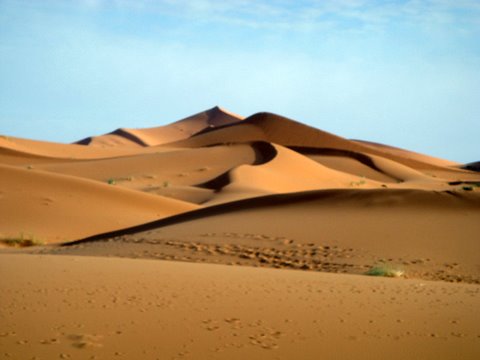 Only one of those caravans still trades in the traditional way, but Berbers in rural areas do keep camels, sheep and goats and they grow mint, grains, vegetables and fruit.
Only one of those caravans still trades in the traditional way, but Berbers in rural areas do keep camels, sheep and goats and they grow mint, grains, vegetables and fruit.
Some of the Berbers work as guides, taking visitors on camel rides into the desert for a unique experience. As one of those visitors, I was interested in learning what it was like to live the nomadic life, even for only a single overnight stay (some are considerably longer). These brief treks are strictly for tourists, but I didn’t care. I wanted that glimpse into another way of life.
In Merzouga our little group stayed at the Auberge Sahara, a 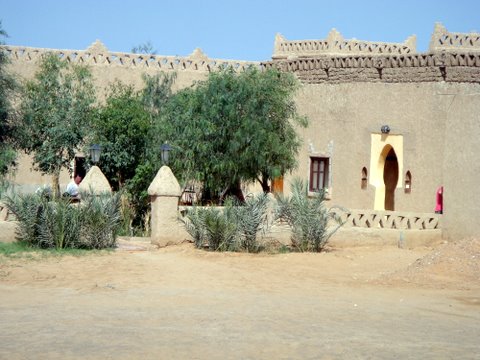 clay-and-straw inn with pleasant rooms, hot showers, and a very welcome swimming pool. Behind the palm trees and over the ridge, camels waited on their knees. We climbed aboard, with help, and the camels tipped forward and back, getting to their feet, until we sat high and wide on padded cushions, nervously clutching the t-bars. When everyone was lined up and ready, white-turbaned guides led us up the next ridge and into the Sahara.
clay-and-straw inn with pleasant rooms, hot showers, and a very welcome swimming pool. Behind the palm trees and over the ridge, camels waited on their knees. We climbed aboard, with help, and the camels tipped forward and back, getting to their feet, until we sat high and wide on padded cushions, nervously clutching the t-bars. When everyone was lined up and ready, white-turbaned guides led us up the next ridge and into the Sahara.
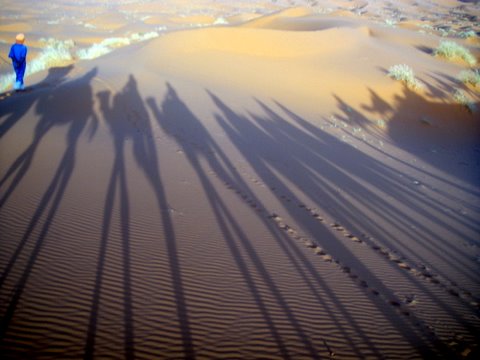 It was magical. Ridges and ravines of golden sand, carved by the wind, stretched to the horizon. The air was dry and still. There were a few sparse shrubs and beetle tracks, but no other signs of life, though we were told there are snakes, lizards and even desert foxes. The desert changed color as we traveled, the camels’ splayed hooves plodding the track. From gold to pale brown to pink, it had an austere, shadowy beauty. Cameras were in constant use, tucked into pockets only when we went steeply downhill and had to cling to the t-bars.
It was magical. Ridges and ravines of golden sand, carved by the wind, stretched to the horizon. The air was dry and still. There were a few sparse shrubs and beetle tracks, but no other signs of life, though we were told there are snakes, lizards and even desert foxes. The desert changed color as we traveled, the camels’ splayed hooves plodding the track. From gold to pale brown to pink, it had an austere, shadowy beauty. Cameras were in constant use, tucked into pockets only when we went steeply downhill and had to cling to the t-bars.
At twilight we reached camp at the foot of a high ridge and tumbled from our camels’ backs, thighs aching. We gathered pads and blankets from a large tent and spread them on the sand while, in a tiny kitchen, a delicious dinner was cooking. Sitting cross-legged at 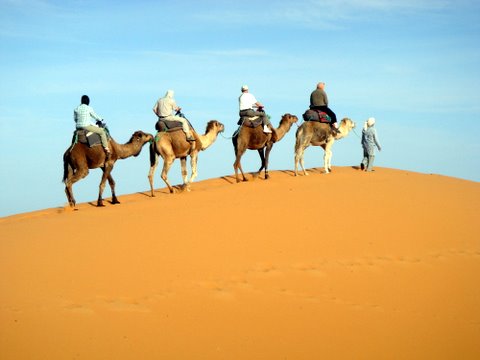 a low table on the sand, we ate by candlelight–fresh tomatoes, corn, onions, and a rich stew with peas and beef. I was just as happy that it wasn’t the typical Berber-on-the-move dish of camel fat mixed with turnips and carrots.
a low table on the sand, we ate by candlelight–fresh tomatoes, corn, onions, and a rich stew with peas and beef. I was just as happy that it wasn’t the typical Berber-on-the-move dish of camel fat mixed with turnips and carrots.
A full, orange moon rose above the desert, and we lay on our makeshift beds to watch the stars appear. They’d be dazzling on a clear night, after the moon set. But it was not to be; clouds gathered, rain fell (a rarity in the desert), and the wind blew sand into our faces as we scurried into tents for the night. Early in the morning, under clear skies , we hoisted onto the camels, again with help from our kindly guides, and turned back toward Merzouga.
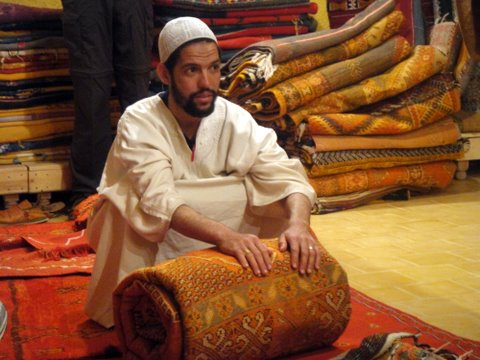 The village has several inns catering to people who want to be near or in the desert. There are also a few shops, and the one I recommend is Depot Nomade, where we saw hundreds of gorgeous, colorful carpets on display and learned how they’re made. Women do the fine handwork, incorporating tradition, lore, legend and personal touches into the designs. At Depot Nomade, I browsed through several rooms of attractive handicrafts and bought lovely silk scarves at bargain prices.
The village has several inns catering to people who want to be near or in the desert. There are also a few shops, and the one I recommend is Depot Nomade, where we saw hundreds of gorgeous, colorful carpets on display and learned how they’re made. Women do the fine handwork, incorporating tradition, lore, legend and personal touches into the designs. At Depot Nomade, I browsed through several rooms of attractive handicrafts and bought lovely silk scarves at bargain prices.


Comments